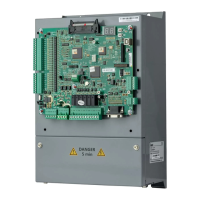
Do you have a question about the INVT EC160 and is the answer not in the manual?
| Brand | INVT |
|---|---|
| Model | EC160 |
| Category | Control Systems |
| Language | English |
Details physical components included in the EC160 system configuration.
Lists and describes the essential software functionalities of the EC160 system.
Describes additional software features that can be added or configured.
Explains the meaning and importance of safety symbols used throughout the manual.
Critical guidelines for safe operation, installation, and maintenance of the EC160.
Instructions for checking the product condition after delivery and upon unpacking.
Steps and precautions for safely taking apart and reassembling the equipment.
Essential guidelines for making electrical connections safely and correctly.
Explanation of the EC160 model naming convention and its components.
Information on how to read and understand the data on the product's nameplate.
Guidance on selecting the appropriate power rating for EC160 models.
Detailed technical data, including input/output, elevator, and interface specifications.
Specifies the recommended environmental conditions for operating the EC160.
Provides physical dimensions and installation space requirements for the EC160 unit.
Details the terminal arrangements and functions for the main electrical circuits.
Describes the terminals and their functions for the control circuitry.
Steps and considerations for installing and configuring the EC160 system.
Details on electrical installation requirements within the elevator hoistway.
Guidance on the correct placement and distance for hoistway switches.
Best practices for installing the system to ensure electromagnetic compatibility.
Specific guidelines for installing the system to meet EMC standards.
Overview of the manual controller's functions for debugging and maintenance.
Describes the information displayed on the main controlling interface.
Explains how to set various system parameters using the manual controller.
Details the process of system autotuning for optimal performance.
Explains the function of each key and LED indicator on the manual controller.
Introduction to the basic functions and operation of the simple manual controller.
Explains the purpose and action of each key on the simple manual controller.
Lists function codes, names, detailed instructions, and default values for system parameters.
How to monitor various states and data of the elevator system.
Monitoring the elevator's current floor, speed, and running status.
How to access and interpret recorded fault information, including code, floor, and time.
Navigation guide to access and view various parameter settings.
Configuration of parameters related to the master drive control.
Setting parameters for acceleration, deceleration, and speed curves.
Configuration of motor-specific parameters like type, power, and electrical characteristics.
Setting up parameters related to the encoder, including type and resolution.
Configuring various protection mechanisms like phase loss and overload protection.
Setting up communication parameters for Ethernet and serial interfaces.
Configuring settings related to elevator floors, including total floors and special floor definitions.
Configuring the logic settings for the input/output signals of the main control board.
Defining which floors the front door will stop at, using binary settings.
Setting up parameters for parallel and group control of multiple elevators.
Configuring various time-related parameters like delays and protection durations.
Setting up various operational functions such as voltage detection and fire safety modes.
Configuring parameters related to calling signals and random running modes.
How to monitor various states and data of the elevator system.
Checking hoistway parameters like floor height and deceleration switch positions.
Pre-power-on checks for machinery and electrical assembly, including connections.
Checks all electrical connections, including power, communication, and safety circuits.
Critical procedure for self-tuning the synchronous motor before initial operation.
Verifies electrical connections, safety switches, and interphone systems.
Steps for powering on the system and performing initial checks.
Procedure for automatically calibrating the elevator's position within the hoistway.
Guidelines and checks for running the elevator at fast speed after setup.
Procedures for ensuring accurate floor leveling and adjusting sensor positions.
Adjustments to improve ride comfort, including vector control sequences.
Tuning PI parameters for the speed loop to optimize dynamic response.
Adjusting current loop parameters to improve control performance.
Details on the EC-CTB main control board, its functions, and interfaces.
Pin assignments and terminal definitions for the EC-CTB board's connectors.
Information on the EC-CCB auxiliary command board, its inputs, outputs, and connections.
Pin assignments and terminal definitions for the EC-CCB board's connectors.
Details on the DC-03F floor displaying board, its interfaces, and parameters.
Pin assignments and terminal definitions for the DC-03F board.
Setting parameters like address and function selection for the DC-03F board.
Information on the MC-GCL group control board, its functions, and communication.
Illustrates the CAN communication interface diagram for group control.
Steps for connecting and performing initial debugging of the MC-GCL.
Monitoring the elevator's calling and running status via the MC-GCL.
Navigation guide to access system clock and floor landing parameters.
Setting the system clock parameters like year, month, day, hour, and minute.
Configuring the home landing floor for different elevator modes.
Configuring running modes like rush hour and zoning based on time and floor settings.
Information on the EC-RDB module for advanced door opening functions.
Wiring diagram showing connections between EC-RDB and EC160.
Routine maintenance checks and recommended intervals for the inverter.
Inspection of conductors, terminals, and PCB for signs of damage or overheating.
Information on the cooling fan's lifespan and replacement procedure.
Step-by-step guide for safely replacing the inverter's cooling fan.
Safety precautions and checks for the power cable connections.
Table showing decimal to binary and hexadecimal conversions for numbers 0-15.
Table defining the characters displayed on a 7-segment display.